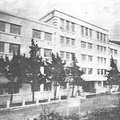Part 1 >>
3. Changes within the Nikkei Community
If we trace the historical transformation of the Nikkei community in Brazil, it is possible to mark several distinct periods: pre-war, immediate post-war, and post-1980s. This can be observed in how the Nikkei community has been described, as well as common perceptions of the community. In other words, it is possible to make distinctions between the pre-war Japanese Brazilian Compatriot Society, the post-war Colônia Japonesa (Nikkei colony), and the post-1980s Nikkei community.
Resident Japanese Compatriot Society, Colônia Japonesa, Nikkei Community
The majority of Japanese immigrants before World War II primarily identified themselves as Nihonjin (Japanese nationals), and from the point of view that they were Japanese subjects residing in Brazil, commonly referred to their collective community as the Resident Japanese Compatriot Society. Following the war, which ended in Japan’s defeat, Nikkei who continued to live as a part of Brazilian society came to be collectively known as “Colônia Japonesa (Nikkei colony).” In this group, Issei held the central roles and emphasized their relationship with Japan, and also maintained a conscious identity as Nihonjin . Following this, as Nikkei were increasingly assimilated into the host society in Brazil, even among Nikkei there were increasingly those who did not consider themselves a part of colônia , but simply considered themselves Brazilian. Including this group of people who no longer found their identity within Colônia Japonesa and didn’t identify themselves as Nihonjin , the totality of Japanese Brazilians came to be called “Comunidade Nippo-brasileira ,” that is, the Nikkei community. Incidentally, Taniguchi was a Nikkei who lived outside of Colônia Japonesa .
As more Nikkei have distanced themselves from Colônia Japonesa , the Colônia has become smaller. However, something that further hastened this process is the post-1980s phenomenon of dekasegi to Japan.
Within the Nikkei community—while this is an obvious point—individual Nikkei identify themselves in many different ways. There are even more people who do not have an awareness of themselves as descendants of Japanese, but rather consider themselves as simply Brazilians. And with the continued decline of the Colônia Japonesa , as its very existence has become endangered, there are numerous undertakings to attempt to restore and reinvigorate it.
4. From Nikkei to “Nikkei ” as a New Identity
As mentioned earlier, there are those among the Nikkei who see a clear distinction between themselves and Japanese. At the same time, they also recognize that they are different from other Brazilians so that there are many Nisei and Sansei who question who they are, and are confused by the ambiguity of Japanese Brazilian identity. Some Sansei have successfully located something intrinsic within this ambiguity, and have constructed a new “Nikkei ” identity with a different meaning from how the term “Nikkei” is understood by Japanese in Japan understand.
Nikkei Identity in Matsuri
Matsuri (festivals) are organized by Nikkei in various regions, some of which are held not simply as community rituals and for entertainment, but are occasions that are used in order to more deliberately assert and express Nikkei identity. The Paraná Folklore and Ethnic Festival held in Curitiba, Paraná, is one such example. There, through dance and taiko, Nikkei demonstrate not only Japanese culture, but also a Nikkei culture that they dedicate themselves to enhancing the entire year. While the Nikkei festivals were founded in order to preserve and pass on Japanese culture, what is on display is not merely Japanese culture, but a distinct Nikkei culture developed by Nikkei. Their reason for this is not simply to imitate Japanese culture. Through such Nikkei cultural practices, they are asserting their unique “Nikkei ” identity.
Nikkei as a New Identity
Japanese usually use “Nikkeijin (Nikkei people)” as a generic term of overseas Japanese immigrants and their descendants. It, however, reflects only the Japanese perspective. Nikkei diversity is rarely properly understood. “Nikkei ” identity is the result of Nikkei asserting and acquiring their own identity. In other words, not everyone who falls within the category of “Nikkeijin ” from a Japanese perspective considers themselves Nikkei . The impact of the development of globalization can be discerned as an important factor. One influence is the rise in information from Japan and the increase in cultural exchange. Another is the transnational communication among Nikkei in different countries. As exchange with Japan increases, there is greater absorption of Japanese culture, and at the same time, greater awareness that Nikkei culture is different from Japanese culture. Further, with the rise in transnational Nikkei exchanges and meetings, there is an increased opportunity for these Nikkei to discover common “nikkeiness,” and while they continue to trace their foundation to Japanese culture, they are also able to discover a distinct Nikkei quality to their culture.
Despite the fact that Cássio Taniguchi, introduced at the beginning of the article, was unknown within the Colônia Japonesa, he was accepted within Brazilian society because Brazilians recognized him as a Japonês . Is it possible to say that he is one who successfully expresses a new Nikkei identity that is distinct from the “Nikkeijin ” label constructed in Japan? The seeds of Japanese culture planted by Japanese immigrants in Brazil have grown in the soil of Brazil, and now through their descendants are being developed into a new Nikkei culture.
References:
Miyao, Susumu. The Borderless Nikkei . São Paulo: São Paulo Jinmon Kagaku Kenkyujo, 2002.
Imin Kenkyukai ed. Wars and Japanese Immigrants . Tokyo: Toyo Shorin, 1997.
Editorial Committee of the Japan-Brazil Interchange History. The Japan-Brazil Interchange History – Retrospects and Prospects in the 100 years of Japanese-Brazilian Relations. Tokyo: Organizing Committee of the Program in Commemoration of the 100th year of the Japan-Brazil Friendship, 1995.
*The original article was published in Japanese in 『アジア遊学 76号-特集・アジア<日本・日系>ラテンアメリカ日系社会の経験から学ぶ』(勉誠出版, 2005).
© 2007 Kojima Shigeru






